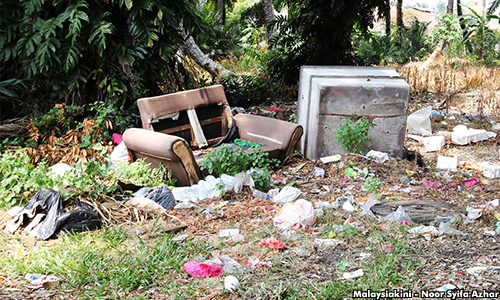
Following close behind the rainy season is mosquito fogging operations carried out by contractors engaged by the Health Ministry and state Health Departments.
We put up with these malodorous operations even though we can already see for ourselves that fogging is ineffective and only provides a false sense of security.
Fogging continues to be a popular way of mosquito control because it is visible and creates the impression that the authorities are doing something to combat mosquito-borne diseases. However, studies have shown that fogging is effective only when the chemicals come in direct contact with mosquitoes.
I have witnessed for myself how the mosquitoes fly up to my apartment window screens when fogging is carried out at ground level, and cunningly fly back down when the coast is clear. There are concerns that frequent fogging may even increase mosquitoes’ resistance to insecticides, giving rise to strains of ''super mosquitoes'' that are hard to destroy.
Fogging does not reduce mosquito populations because it does not kill mosquito larvae. If fogging were an effective mosquito control method, we would see a decrease and not increase in dengue cases in Malaysia.
Fogging is not only ineffective in controlling mosquito populations but potentially harmful to human health. The chemical pesticides used in fogging and spraying are neurotoxins that can adversely affect the nervous systems of humans, companion animals, and birds, among others.
Fogging also kills beneficial insects such as ladybirds, and pollinators such as butterflies and bees, and frequent fogging operations can harm biodiversity and cause ecological imbalance.
There are inexpensive and pesticide-free methods of mosquito control advocated by biologists and researchers. It often involves getting home/building owners and cleaning contractors to identify and eliminate mosquito breeding sites.
Include checks at less-expected breeding sites such as the bracts of flowers and plants, septic tanks, gutters, and damp bathroom floors. Increasing biodiversity in parks and gardens by bringing in native fish, frogs, dragonflies, and bats that feed on mosquitoes and their larvae can help reduce mosquito populations and restore degraded ecosystems.
The release of genetically-modified mosquitoes to either suppress pathogen infection or mosquito reproduction also seems to bear promising results, although it may be a few years before we can conclusively attest to their safety and effectiveness, and assess their impact on ecosystems.
In the meantime, the best and safest method of mosquito control is still the elimination of breeding opportunities.

I conduct community clean-ups and often find municipal rubbish bins, recycling bins, and construction waste bins filled with stagnant water and mosquito larvae. There should be a requirement for all such bins to have drainage holes at the bottom to allow water to flow out.
Local councils should ensure that abandoned vehicles are removed, and construction sites and illegal dumpsites are cleared regularly as these spaces often trap water and create places for mosquitoes to breed.
The elephant in the room that few want to address is the role of single-use plastics and other disposable packaging in creating breeding grounds for mosquitoes, besides being a blight on the environment.
While our government continues to hem and haw over whether or not to ban single-use plastics, mosquitoes continue to breed in discarded cups, bottles, plastic bags and food takeout containers.
A ban on single-use plastics combined with a bottle and can deposit system would go a long way towards reducing litter, encouraging recycling, and keeping these mosquito nurseries out of the environment and landfills, but there seems to be no political will to implement it in Malaysia.
The other elephant in the room is the link between deforestation and the rise in mosquito-borne diseases. The Journal of Emerging Infectious Diseases has documented the steep increase in malaria cases in parts of East Malaysia where forested land has been cleared for agriculture.
Larvae-sustaining puddles are formed where there are no longer tree roots to control soil erosion and water runoff, and mosquitoes and other pathogens proliferate in forest edges where the boundaries between human habitation and forested areas become blurred and primates and other disease carriers wander into human habitation.
To protect citizens from mosquito-borne diseases, the government needs to look at all the different factors contributing to the rise in mosquito-borne diseases, and implement agricultural policies that may include banning the clear-cutting of forests, practising shade and mixed cultivation, and increasing biological pest control measures such as bringing back native fishes, frogs, bats, and birds to degraded areas.
We need a responsive and responsible government that focuses on disease prevention and implements measures to identify and eliminate mosquito breeding sites and opportunities.
Fogging is, at best, a piecemeal attempt at appeasing local communities after a dengue outbreak. These disruptive fogging sessions cannot be allowed to continue at the expense of our comfort, health, and safety. Citizens already know that mosquito fogging operations harm nothing but taxpayers’ wallets.
It’s time we stopped pretending they are effective and redirect our resources to actual solutions. - Mkini


No comments:
Post a Comment
Note: Only a member of this blog may post a comment.